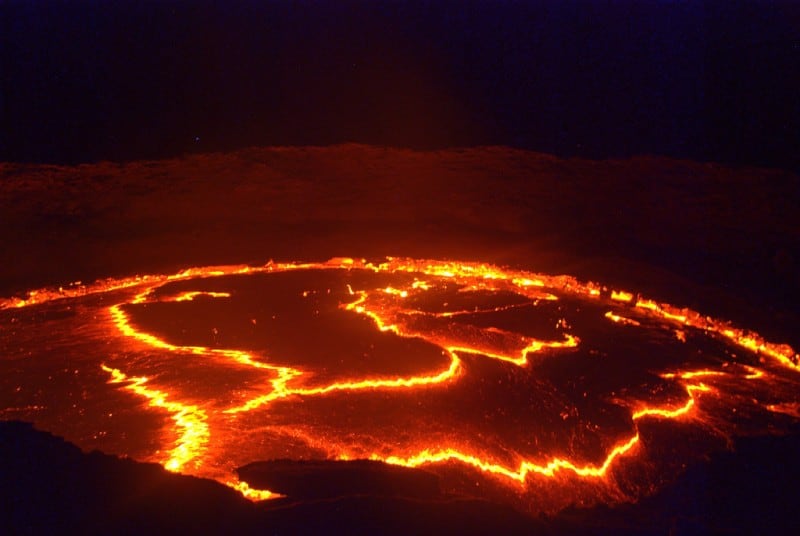
Erta Ale Facts
- The short term of Erta Ale serves as the english language name for this spellbinding creation of naturally occurring geological forces. Like many such incredible features around the globe, it does have another, previously used moniker, though.
- It orginally bore the name of Irta’ale in the native language of the indigenous population of its region. The commonly used title for the feature translates as smoking mountain. It comes from the ancient tongue of the local Indigenous People, the Afar.
- Obviously, the original inhabitants of the area have known of its existence for untold centuries. It’s unclear precisely when the first non-natives first spotted it, though. But, reports of sightings by various European explorers date back to the 16th century.
- Those reports, however, only mentioned the volcano itself. The most remarkable individual characteristic of the mountain, though, wasn’t reported until 1960! It’s believed that this, an extraordinary lava lake, formed about 107 years ago.
- Unfortunately, researchers still have only a very limited knowledge of Erta Ale. The terrain in the immediate area remains considered some of the most inhospitable in the world. This makes access to the site both extremely difficult and dangerous.
Related Articles
Erta Ale Physical Description
The eerily magnificent Erta Ale is an indescribably unique location. In some ways it’s an utterly unique formation. It therefore draws a great deal of interest for its natural wonders. The site garners such intense interest due to a combination of remarkable aspects.
Though certainly not the tallest volcano currently known to man, it nonetheless boasts a respectable size. In its present state, the mountain stands roughly 2,011 ft (613 m) tall. The base of the impressive formation also has an astonishing diameter measuring 31 mi (50 km)!
The caldera of this natural wonder further holds correspondingly attention-grabbing dimensions. This part of the awesome site’s roughly rectangular in shape. It measures approximately 1 mi (1.6 km) in length. Its width also stands out, at about 0.43 mi (0.7 km).
Simple size isn’t the only tantalizing aspect of the caldera, though. That’s because this itself holds two pit craters within it. Evidence indicates that both of these often held lava lakes throughout their history. Only seven other volcanoes on earth host such active features.
The largest of the two of these within Erta Ale has a width of roughly 1,148 ft (350 m). It’s also about 656 ft (200 m) deep. The southern of the two ranks as the smaller of the pair. It’s roughly 328 ft (100 m) in depth. The measured diameter equals about 213 ft (65 m).
Though smaller than its companion, it’s by far the most famous. This stands out as the longest continually active feature of its kind known to science. Its longevity and unearthly appearance remain unlike any other. This garnered it the popular name of Gateway to Hell.
Erta Ale Location, Formation, and History
The location of the otherwordly creation of time and geological activity known as Erta Ale doesn’t surprise many people. That’s due to the fact that it formed in a part of the world widely known for its natural wonders. Nature provided the region with countless such.
More precisely, the volcanic mountain formed on what’s now known as the continent of Africa. It’s centered over what’s popularly known as the East African Rift. That places it in the Afar Region of northeastern Ethiopia. It also locates it within a local desert.
It’s very formation further distinguishes the mountain from other sites of its kind. That’s due to the fact that it’s the product of a triple junction of tectonic plates. To the present knowledge of geologists, this is the only place on earth where such a conjunction happens.
The movement of these plates creates the forces responsible for its many unique traits. The distinctive mount lies 246 ft (75 m) below sea level, because of the downward thrust of one of the plates. The mountain itself’s comprised of material slowly pushed upward.
Haunting yet captivating Erta Ale holds its share of perils, though, to be certain. Though far less common than its continued slow activity, eruptions do occur sporadically. In August of 2007, a flow escaped the crater, forcing an evacuation of hundreds of local residents.
Explosive eruptions also happen sometimes. In both 2008 and 2017 scientists reported these occurring. The last major eruption took place on September 25, 2005. During this event, thousands of inhabitants fled, two disappeared, and several hundred cattle perished.
Features Sharing Its Region
Check out our other articles on Old Faithful, 3 Fabulous North American Felines, Mount Roraima, Stromboli, Bloody Hell Pond, Gates of Hell, Malaysian Dead Leaf Mantis
